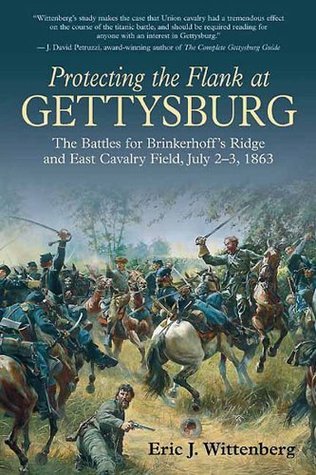What do you think?
Rate this book


Few aspects of the battle of Gettysburg are as misunderstood as the role played by the cavalry of both sides. Protecting the Flank at Gettysburg: The Battles for Brinkerhoff’s Ridge and East Cavalry Field, July 2-3, 1863 by award-winning author Eric J. Wittenberg is the first and only book to examine in significant detail how the mounted arm directly affected the outcome of the battle.
On July 3, 1863, a large-scale cavalry fight was waged on Cress Ridge four miles east of Gettysburg. There, on what is commonly referred to as East Cavalry Field, Union horsemen under Brig. Gen. David M. Gregg tangled with the vaunted Confederates riding with Maj. Gen. Jeb Stuart. This magnificent mounted clash, however, cannot be fully appreciated without an understanding of what happened the previous day at Brinkerhoff’s Ridge, where elements of Gregg’s division pinned down the legendary infantry of the Stonewall Brigade, preventing it from participating in the fighting for Culp’s Hill that raged that evening.
Stuart arrived at Gettysburg on the afternoon of July 2 after his long ride around the Army of the Potomac just in time to witness the climax of the fighting at Brinkerhoff’s Ridge, and spot good ground for mounted operations one ridge line to the east. Stuart also knew that Gregg’s troopers held the important Hanover and Low Dutch road intersection, blocking a direct route into the rear of the Union center. If Stuart could defeat Gregg’s troopers, he could dash thousands of his own men behind enemy lines and wreak havoc. The ambitious offensive thrust resulted the following day in a giant clash of horse and steel on East Cavalry Field. The combat featured artillery duels, dismounted fighting, hand-to-hand engagements, and the most magnificent mounted charge and countercharge of the entire Civil War.
This fully revised edition of Protecting the Flank at Gettysburg is the most detailed tactical treatment of the fighting on Brinkerhoff’s Ridge yet published, and includes a new Introduction, a detailed walking and driving tour with GPS coordinates, and a new appendix refuting claims that Stuart’s actions on East Cavalry Field were intended to be coordinated with the Pickett/Pettigrew/Trimble attack on the Union center on the main battlefield.
220 pages, Kindle Edition
First published August 1, 2002